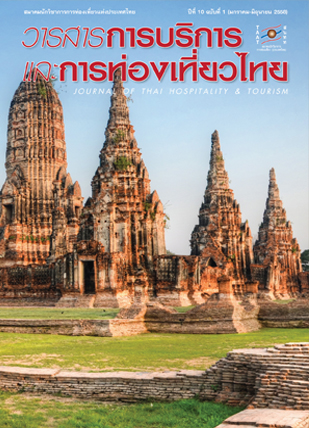Perception of International Tourists on Thailand Tourism Brand Under The "AMAZING THAILAND" Campaign
Main Article Content
Abstract
The objective of this study was to find out the perception of brand identity designed for tourism promotion in Thailand’s Tourism Marketing Plan for 2009 under the “Amazing Thailand” campaign highlighting the theme of Seven Wonders of Amazing Thailand. The research methodology involved both qualitative and quantitative approaches. The data was collected from four geographic regions of travel originating countries including Asia, America, Europe, and Oceania. Totally 420 samples of international tourists from the countries in the above-defined regions were covered as questionnaire respondents for the opinion survey. The qualitative research was the in-depth interview with international tourists to obtain information for performing Content Analysis and for use as a background to develop the questionnaire to serve the purpose of the present study. The quantitative research was a questionnaire survey to collect data for the validity test of the study concept to assure its clarity and generalization. The result revealed that the memory of international tourists, the meanings of nation brand for visit to Thailand could be expressed in the dimensions of culture and event, value for money, attractions, quality of services and people, and geographic location. From the investigation on the awareness of the target international tourists of the nation brand identity for Thailand’ tourism promotion under the Seven Wonders of Amazing Thailand campaign, it was found that the awareness was clear for the following themes: Nature: The Beauty of Natural Wonders, Beaches: Sun Surf and Serenity, Treasures: Land of Heritage and History, and Thainess: The World’s Friendliness Culture; while quite vague for the following themes: Health & Wellness: The Beauty of Wellness and Well-being, Trends: Your Senses with Unique Trends, and Festivities: The Land of Year-Round Festivities. From the cross-sectional analysis of various target groups, the international tourists from European and American countries demonstrated to have a clearer awareness of sun, surf, and serenity element than those from Asian countries and Oceania. The present study also found that certain elements of the nation brand identity had effect on international tourists’ satisfaction, which included authenticity, accessibility, and quality of service; and that some elements could be important determinants of the brand loyalty giving rise to repeat visits to Thailand such as quality of shopping facilities, quality of accommodation facilities, accessibility, and different gastronomy.
Article Details
References
[2] การท่องเที่ยวแห่งประเทศไทย. (2554). รายงานประจําปีการท่องเที่ยวแห่งประเทศไทยปี 2553. กรุงเทพฯ: การท่องเที่ยวแห่งประเทศ.
[3] กรมการท่องเที่ยว. (2554). สถิตินักท่องเที่ยว.วันที่ค้นข้อมูล 20 มิถุนายน 556, จากกรมการท่องเที่ยว http://tourism.go.th/2010/th/statistic/tourism.php?cid=30.
[4] กรมการท่องเที่ยว. (2554). สรุปสถิติการท่องเที่ยวประเทศไทยปี 2553. วันที่ค้นข้อมูล 18 พฤษภาคม 2555, จาก กรมการท่องเที่ยว http://tourism.go.th/2010/upload/filecenter/file/stat_2554/march/North.xls.
[5] บุญเลิศ จิตตั้งวัฒนา. (2548). การพัฒนาการท่องเที่ยวแบบยั่งยืน. กรุงเทพฯ: เพรสแอนด์ & ดีไซน์.
[6] สุดาวรรณ เตชะวิบูลย์วงศ์. (2543). กระบวนการสื่อสารเชิงสัญลักษณ์ผ่านสื่อมวลชนในอุตสาหกรรมการท่องเที่ยวยุคหลังสมัยใหม่ในโครงการ Amazing Thailand. กรุงเทพมหานคร: ฐานข้อมูลวิทยานิพนธ์ไทย.
[7] สํานักงานการท่องเที่ยวกระทรวงท่องเที่ยวและกีฬา. (2552). รายงานฉบับสมบูรณ์โครงการสํารวจพฤติกรรมการเดินทางของนักท่องเที่ยวภายในประเทศ. วันที่ค้นข้อมูล 18 พฤษภาคม 2555, จาก สํานักงานการท่องเที่ยวกระทรวงท่องเที่ยวและกีฬา. http://tourism.go.th/2010/th/statistic/tourism.php?cid=27.
[8] อรชร มณีสงฆ์, นฤมล กิมภากรณ์ และธันยา พรหมบุรมย์. (2553). พฤติกรรมของนักท่องเที่ยวชาวไทยต่อการท่องเที่ยวภาคเหนือตอนบนของประเทศไทย. เชียงใหม่: คณะบริหารธุรกิจมหาวิทยาลัยเชียงใหม่.
[9] Bernd H. Schmitt. (1999). Experiential marketing: How to get customers to sense, feel, think, act, relate. New York: Simon and Schuster.
[10 Bongkosh Ngamsom Rittichainuwat, Jeffrey A. Beck & Hailin Qu. (2002). Promotional Strategies and Travelers’ Satisfaction During the Asian Financial Crisis. Journal of Quality Assurance in Hospitality & Tourism. 3 (1-2), 109-124.
[11] European Institute for Brand Management. (1991). Aaker’s Brand Equity Model. Retrieved June 20, 2013, from the European Institute for Brand Management http://www.eurib.org/fileadmin/user_upload/Documenten/PDF/Merkmeerwaarde_ENGELS/s_Brand_equity_model_by_Aaker_EN_.pdf.
[12] Edith Smit, Fred Bronner, & Maarten Tolboom. (2007). Brand relationship quality and its value for personal contact. Journal of Business Research. 60(6), 627-633.
[13] Hong-bumm Kim and Woo Robbins, S. P. (2003). Organizational behavior. Englewood Cliffs. NJ: Prentice-Hall. 10th ed., 124.
[14] Roderick J. Brodie, James R.M. Whittome and Gregory J. Brush. (2008). Investigating the service brand: A customer value perspective. Journal of Business Research. 62(3), 345-355.
[15] Scott M. Davis. (2002). Brand Asset Management: Driving Profitable Growth through Your Brands. San Francisco, Josey Bass.

